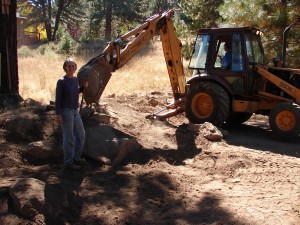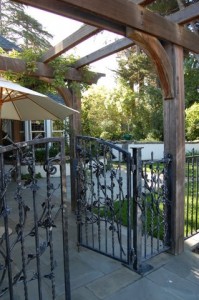What to do with all that creative garden energy while you wait for fall to plant? Get the rest of the landscape ready! Plants should be the finishing touch on a garden to protect them from damage during other gardening projects.
Once you’ve completed your garden master plan, decide whether you want to tackle the whole garden or divide it into smaller projects to be completed individually. Which ever approach you take, there may still be infrastructure projects that should be done first to avoid conflict later on. The key concept: Don’t paint yourself into a corner!
At the top of the list is grading your site to ensure drainage away from your house and other structures. Water is the enemy of buildings. Take the time now to evaluate and correct any problems you have with drainage. At the least, make sure that all earth and paving slopes away from your house for a minimum of 5′. If you have dampness or puddling near or under your house or smell mold or mildew during wet seasons, you may need to install drainage structures such as drain inlets/piping or french drains to carry water away from your house.
Consider where you may need to use heavy equipment and make sure that your current phase of construction doesn’t block access routes.
If you are adding an automatic irrigation system, electric lighting, or gas for a barbecue, consider the needs of the entire garden and where your piping or wiring will need to go. Trench and install piping or sleeves (larger diameter piping through which the actual pipes can be run) in areas that will be constructed during your current phase to service future phases. If piping or sleeves must run through paved areas, make sure it is installed well below grade to allow for excavations for base rock, sand, and paving materials.
Do you want to replace your lawn with drought tolerant native plants? Summer is the time to let the sun do the work of killing your lawn using a technique researched by UC Davis called Solarizing.
Once your infrastructure projects are finished, you can start adding the fun stuff. Construct your hardscapes such as paving, decks, walls, shade structures, boulders, etc., now. Keep referring to your master plan; sequence construction to avoid future conflicts. For example, if you want a pergola over your stone patio, get footings and post bases in before you pave.
After construction is complete, prepare your soil for planting. Loosen compaction caused by construction. If you are planting edibles or ‘traditional’ landscape plants (i.e., not natives), amend the soil as necessary.
And, finally, when fall arrives, you are ready to install your plants. They’ll put their energy into root development and reward you with vigorous growth and vitality next spring.

